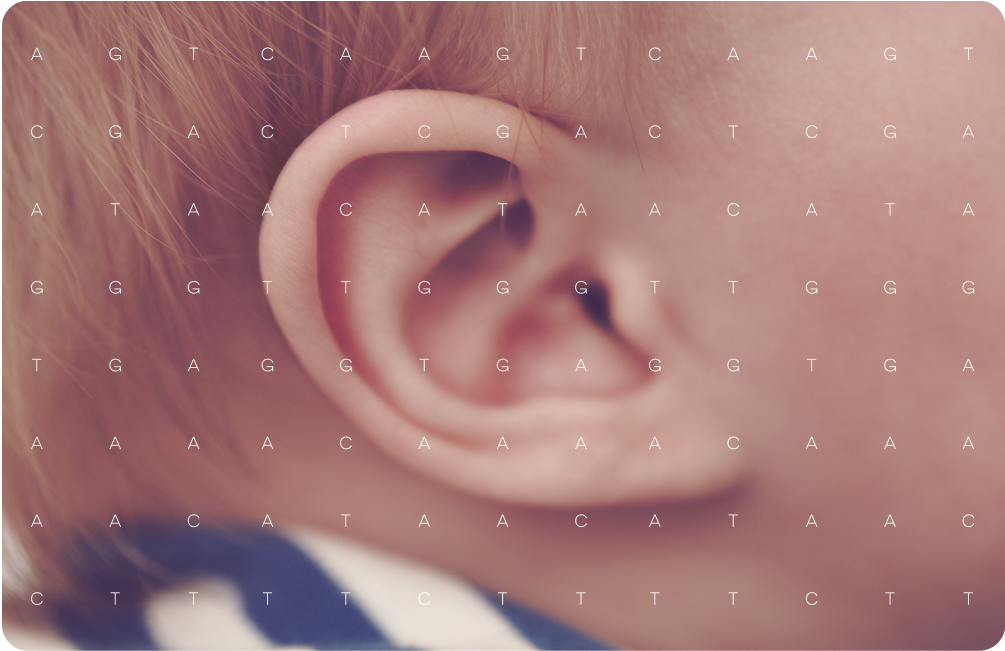Advancing the diagnosis of genetic hearing loss

Diagnosing genetic hearing loss hasn’t always been straightforward. With so many different causes and overlapping symptoms, traditional methods have often struggled to provide clear answers—especially when genetic sequencing was expensive and less accessible. But as technology advances, genetic testing is making diagnosis faster, more accurate, and more affordable, opening the door to earlier interventions and better treatment options.
Small(er) scale sequencing
The high prevalence of connexin 26 variants in cases of genetic hearing loss means that single gene or sequential screening approaches were the standard screening method until the early 2010s – despite there being more than 120 genes associated with genetic hearing loss. Single gene tests would commonly check for the presence of GJB2 variants, and sequential tests for GJB2 and GJB6 variants. However, these types of sequencing were very limited, missing any genetic diagnoses falling outside of these variants and taking up to three months per gene at a cost of approximately $1,800 USD.
Not only were these types of sequencing costly and slow moving, their limitations also had real-world impact on patient outcomes. Accurate diagnosis of genetic hearing loss is crucial for effective clinical management and prognosis. Inadequate screening may lead to missed or incorrect diagnoses, which can negatively affect quality of life and obscure important information for family members.
Imaging and physical examinations
Imaging the ear’s temporal bone using computed tomography (CT) or magnetic resonance imaging (MRI) has also been a standard diagnostic approach, helping clinicians to assess the bone structures of the ear and check for any anomalies indicative of hearing loss. This type of diagnostic approach has historically helped to establish a diagnosis and guide treatment decisions such as surgical interventions.
However, these diagnostic approaches have significant limitations when it comes to identifying genetic hearing loss. For example, imaging results have a limited correlation with genetic causes, and many genetic hearing loss patients present with normal temporal bones; only about 10% of patients with biallelic GJB2 variants show any temporal bone abnormalities on imaging. Additionally, temporal bone abnormalities may be present in both genetic and non-genetic causes of hearing loss, making it hard to distinguish the cause of these changes from imaging results alone.
With the cost of more comprehensive genetic screening decreasing significantly, and the roll-out of newborn screening programs across multiple countries, temporal bone imaging is now widely regarded as having a complementary rather than primary role in the diagnostic process.
Precision medicine and genetic hearing loss
Increasingly comprehensive screening options
The good news is that the development and decreasing cost of Next Generation Sequencing (NGS) techniques means that patients can be screened for a much higher number of genes in significantly less time and at a dramatically reduced cost, with whole genome sequencing (WGS) now at about $600. In the context of genetic hearing loss, this means much more comprehensive testing is now available and financially accessible. As of July 2022, there were at least 18 hearing loss focused panels recorded on the Genetic Testing Registry, each containing an average of 121 genes.
Thanks to NGS approaches, clinicians are able to effectively address the heterogeneity of genetic hearing loss and accurately diagnose hearing loss subtypes, enabling patients and families to take empowered and personalized action based on their unique circumstances.
Enabling effective newborn screening
The increasing accessibility of Next Generation Sequencing is now changing the way clinicians and researchers approach diagnosing genetic hearing loss. Universal neonatal hearing screening (UNHS) programs in countries including the United Kingdom, United States, China, Australia and New Zealand, are helping to significantly increase the number of genetic hearing loss diagnoses around the world and providing patients and families with actionable insights which result in significantly improved hearing outcomes.
In countries where UNHS screening programs are available, the average uptake is high, with England reporting an uptake rate of approximately 99%, Wales 99%, the US 98%, and one study showing a 90% uptake in Oman. However, historicdata shows slightly lower rates in China and New Zealand, with 87% and 85% national uptakes respectively.
High uptake rates and the successful roll out of these programs are particularly significant in light of the fact that more than 90% of babies identified with hearing loss through US genetic screening initiatives are born to hearing parents with no family history.
Identifying subtypes
Not only does genetic screening enable families to identify risk and underlying cause of hearing loss, it also enables early and accurate diagnosis of hearing loss subtype. This empowers families to work with clinicians to gain actionable insights which enable the best possible outcome. Screening can also form the foundation of effective genetic counseling, helping families to understand how the condition may or may not progress over time, inform decisions around interventions such as cochlear implants, and provide valuable information about if other future children are likely to be affected.
Identifying which specific genetic biomarkers are present is vital for enabling early detection and diagnosis, honing in on the underlying cause, and, critically, guiding treatment and management of hearing loss in an effective and personalized way.
Discover the Future of Genetic Hearing Loss Diagnosis
Genetic testing is changing the way we understand and diagnose hearing loss, making it faster, more accurate, and more accessible than ever. Download out latest whitepaper to discover the latest advancements and what they mean for the future of hearing loss diagnosis.

